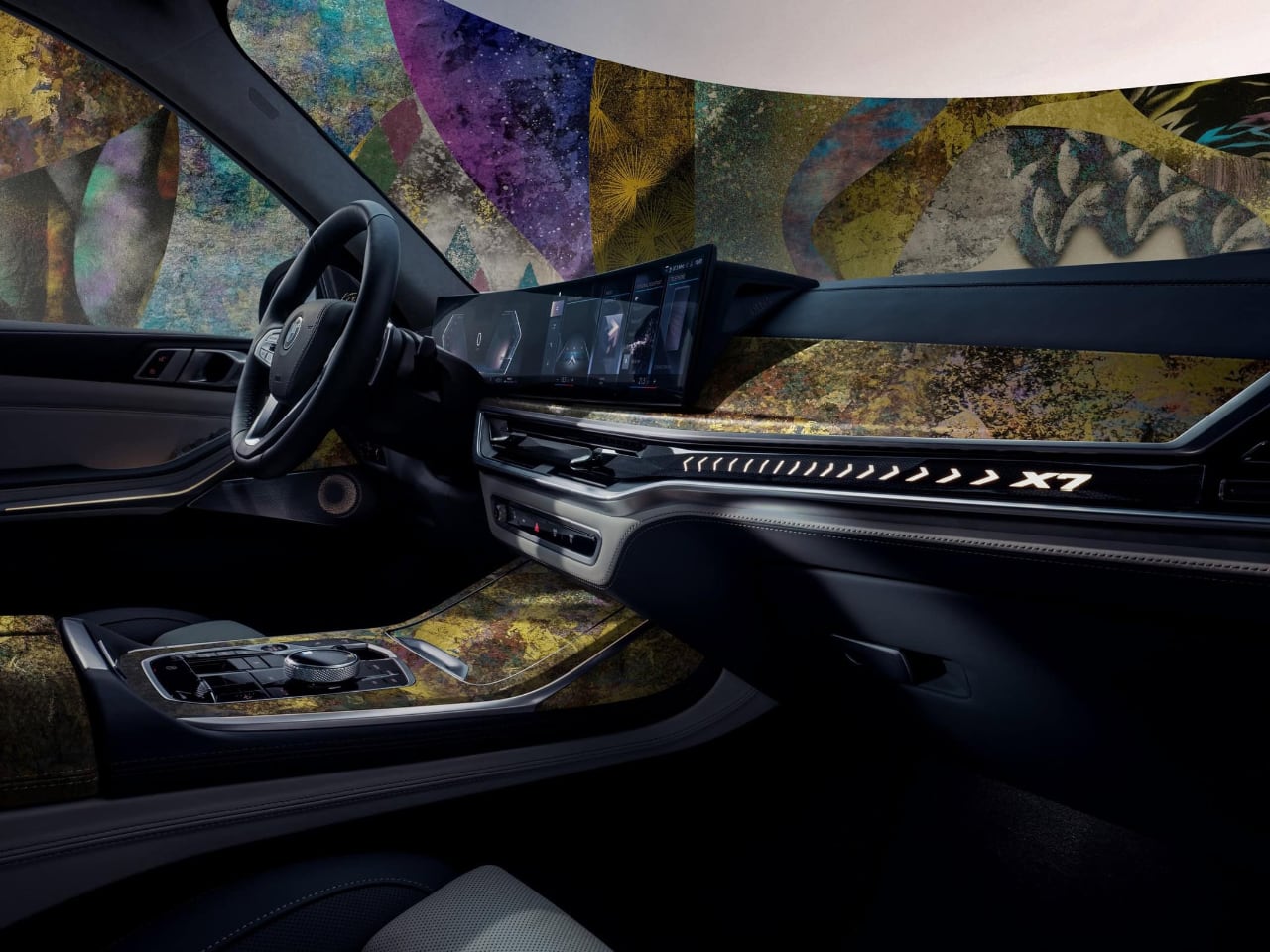BMW has introduced two-tone paint options for the X7 SUV, marking the first time this customization appears on their largest vehicle. The German automaker now offers 12 traditional Japanese patterns for the interior trim, complete with foil decoration across the dashboard, center console, and door panels. This expansion of the BMW Individual program gives X7 buyers access to combinations that transform the seven-seater into a personalized statement piece.
Designer: BMW
The two-tone approach follows the same technique BMW uses on the 7 Series sedan. Customers select one color for the lower body section and a contrasting shade for the upper portion, with a hand-applied coach line creating the visual separation between zones.
How BMW Creates the Two-Tone Effect
The paint process starts with the base color application on the lower body panels, including the doors, fenders, and bumpers. After curing, technicians mask off specific areas and apply the contrasting color to the roof, pillars, and upper door frames.
The coach line gets painted by hand, requiring steady precision to maintain consistent thickness and alignment across the entire vehicle. BMW offers over 165 Individual paint colors for these combinations. Popular choices include deep metallics like Tanzanite Blue paired with lighter tones such as Mineral White, or bold contrasts like Fire Orange with Jet Black. The paint shop uses multiple clear coat layers to ensure both colors maintain their depth and protection over time.
Quality control involves detailed inspection of the color transition areas, checking for overspray, uneven coverage, or imperfections in the coach line application. Each vehicle receives individual attention during the painting process, with touch-ups performed as needed before final approval. This level of scrutiny explains why Individual vehicles take longer to complete than standard production models.
Japanese Pattern Integration in the Interior
The 12 Japanese-inspired patterns draw from traditional textile and ceramic designs, adapted specifically for automotive surfaces. Each pattern uses metallic foil application techniques that create texture and visual depth across the interior panels.
The designs range from geometric cherry blossom motifs to abstract wave patterns, all scaled appropriately for the X7’s cabin dimensions. Installation begins with precise measurement and cutting of the foil materials to match each interior surface. The dashboard receives the most prominent pattern placement, extending from the instrument cluster housing to the passenger side trim panels.
Door panels feature coordinated designs that flow naturally from the dashboard elements, creating visual continuity throughout the cabin. The center console treatment includes pattern elements that complement the gear selector surround and cup holder areas. Even the door handle recesses receive decorative touches that tie into the overall design theme.
This comprehensive approach ensures the Japanese influence appears integrated rather than applied as an afterthought. Adhesive backing on the foil materials provides permanent attachment while allowing for expansion and contraction with temperature changes. The materials resist fading from UV exposure and maintain their metallic luster throughout normal use.
Customization Process and Pricing
BMW Individual advisors work directly with customers to select paint and interior combinations. The consultation includes digital visualization tools that show how different options will appear in the finished vehicle.
This preview capability helps customers understand how bold color contrasts will look in real-world lighting conditions. Production scheduling accommodates the additional time required for two-tone painting and interior pattern installation. Each Individual X7 receives dedicated build slots that allow craftspeople to complete the specialized work without rushing.
The process typically adds 4-6 weeks to standard delivery times. Pricing for the two-tone paint option starts at approximately $8,000 above standard Individual paint costs. The Japanese interior patterns add another $6,000 to $12,000 depending on the complexity and coverage area selected.
These prices reflect the hand-applied nature of the work and the specialized materials involved. BMW provides detailed care instructions for maintaining both the exterior paint and interior patterns. The two-tone finish requires careful attention during washing to avoid damage to the coach line, while the interior patterns need specific cleaning products to preserve their metallic properties.
Where Art Meets Asphalt
The X7’s massive frame becomes a moving canvas that demands attention at every intersection. When a Storm Bay metallic upper meets Frozen Dark Grey below, separated by that precise coach line, the result stops conversations mid-sentence.
This isn’t just a big SUV anymore, it’s a 5,400-pound statement that announces its owner’s refusal to blend into traffic. BMW’s selective rollout targets the markets where automotive individualism thrives. American buyers who park their rides in country club driveways, German enthusiasts who understand the difference between transportation and expression, and Asian customers who view their vehicles as extensions of personal success stories.
These aren’t people shopping for basic mobility, they’re commissioning automotive art pieces. The Japanese interior patterns represent BMW’s most audacious design gamble in decades. While competitors stick to predictable wood grains and carbon fiber weaves, BMW just invited 1,000-year-old artistic traditions into the cockpit of a modern SUV.
The implications ripple beyond this single model, potentially opening doors to Moroccan tile-inspired dashboards or Aboriginal dot-painting door panels. Bentley’s hand-stitched leather suddenly looks quaint compared to BMW’s cultural deep dive. Rolls-Royce’s starlight headliners pale next to foil-applied cherry blossom patterns that transform the X7’s interior into a meditation on traditional craftsmanship.
The luxury SUV battlefield just shifted from material quality to cultural storytelling. Production constraints create the perfect storm of desire and scarcity. BMW’s Individual artisans can only complete a handful of these cultural masterpieces each month, turning every completed X7 into a collector’s item before it leaves the factory.
The waiting list becomes part of the appeal, proving that true customization cannot be rushed or mass-produced. The X7 earned its canvas status through pure automotive physics and buyer psychology. At this size and price point, subtlety becomes irrelevant. Owners want their investment to command respect in the valet line, dominate the school pickup queue, and spark conversations at every red light.
The post BMW X7 Gets Two-Tone Paint and Japanese-Inspired Interior Design first appeared on Yanko Design.

